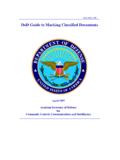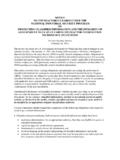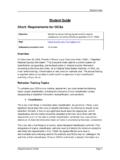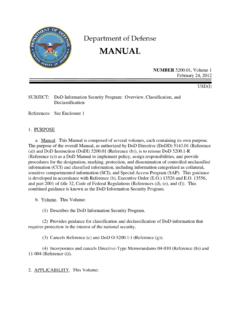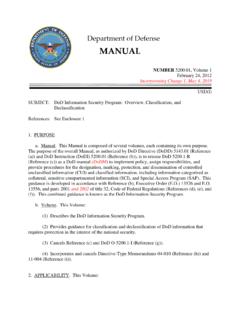Transcription of 19980325 078 - Defense Technical Information Center
1 DoD Guide to Marking classified DocumentsApril 1997 Assistant Secretary of DefenseforCommand, Control, Communications and Intelligence19980325 078 ASSISTANT SECRETARY OF DEFENSE6000 Defense PENTAGONWASHINGTON, DC 20301-6000 COMMAND, , AND FOREWORDINTELLIGENCEThis Pamphlet is reissued under the authority of DoD Directive , "InformationSecurity Program," December 13, 1996. It prescribes guidance through examples, onthe markings for classified national security Information . It supersedes the 1982, guidance contained is derived from the 12598, " classified National SecurityInformation," its implementing instructions, and the marking guide developed by theInformation Security Oversight Office. This pamphlet applies to the Office of theSecretary of Defense (OSD), the Military Departments, the Chairman of the joint Chiefsof Staff, the Defense Agencies, and the DoD Field Activities (hereafter referred tocollectively as "the DoD Components").
2 Marking classified Information serves several purposes in the Department of Defense . It Nalerts holders to the presence of classified Information , identifying the exact informationor portion that needs protection; provides guidance for downgrading anddeclassification; gives the reason for the initial classification decision; and warns theholders of any special access, controls, or safeguarding requirements. While we can notanticipate every marking situation, this pamphlet provides the basic ground rules thatapply to all classified Information , regardless of the media used. For specific situationalneeds, contact your agency's security officer for Pamphlet is effective immediately for use by all the DoD Components. The Headsof the DoD Components may issue supplementary instructions when necessary toprovide for unique requirements within their recommended changes to the Pamphlet to:Office of the Assistant Secretary of Defense for Command, Control,Communications, and IntelligenceDirector, Security Programs6000 Defense Pentagon :X,- I C~TF,Washington, DC 20301-6000 The DoD Components may obtain copies of this Pamphlet through their ownPublications channels.
3 Approved for public release; distribution unlimited. Authorizedregistered users may obtain copies of this Publication from the Defense TechnicalInformation Paige, of ContentsF orew ord .. 1 Table of C ontents .. 2 Security R em inders .. 3 Section 1 -Marking Originally classified Documents .. 4 Portion Markings and Overall Classification Markings 5" classified by" and "Reason for Classification" Line. 8"D eclassify on" Line .. 9"Exemption Categories" chart .. 10W orking Papers .. 11 Electronically Transmitted Messages .. 12 Section 2 -Marking Derivatively classified Documents .. 13 Classifying from "Multiple Sources" .. 16 Marking from a "Classification Guide" .. 19 Section 3 -Marking Special Types of Information and Materials. 20 Classification Extensions .. 20 Foreign Government Information .
4 21 Letters of Transmittal .. 22 Atomic Energy Information .. 24 Classification by "Compilation" .. 25 Special Access Programs .. 26 Section 4 -O ther .. 29 Automatic Declassification Instructions -25 yr. rule .. 29 Marking Information "Other Than" Documents .. 30R eferences .. 34N otes .. 352 Security RemindersA. Classification decisions are either original or Only individuals occupying positions specifically authorized in writing may classifydocuments Only individuals with the appropriate security clearance, who are required by theirwork to generate classified source Information , may classify There are three levels of classification, "TOP SECRET", "SECRET" and"CONFIDENTIAL." Do not use other terms, such as "Official Use Only," or"Administratively Confidential," to identify classified national security Information shall not be classified for any reason unrelated to the protection of Classifiers are responsible for assuring that Information is appropriately classified andproperly marked.
5 The proper markings include declassification To have access to classified Information , a person must have a security clearance at anappropriate level, a signed SF 312, " classified Information Nondisclosure Agreement,"and the "need-to-know."H. Individuals who believe that Information in their possession is inappropriatelyclassified, or inappropriately unclassified, are expected to bring their concerns to theattention of their security manager or the classifier of the Information for classified Information shall not be discussed or read in public places. It should not be leftunattended, even for a short time in automobiles, hotel rooms, private residences or publiclockers. Only approved security containers are authorized for classified Information shall not be discussed on non-secure telephones.
6 "Talking around"is a dangerous practice and does not provide adequate protection to classified nationalsecurity Notes, rough drafts, informal working papers, and other preliminary documents must behandled and destroyed as classified Information . This is especially important withcomputer generated documents that often go through several revisions. Apply themarkings as the document is being 1 -Marking "Originally classified " DocumentsSECRET (OFFICE OF THE SECRETARY OF DEFENSEWASHINGTON, DCdateMEMORANDUM FOR DASD (I&S) SUBJECT: Classification Markings (U)1. (U) This is an example of a document that contains originally classified Information . Standardmarkings are required for all documents as shown here. These markings include:a. (U) Portion marking(s) for each section of a document to reflect the classification of theinformation.)
7 When using subsections such as shown here, individual markings are used. Whensubsections are not marked, the Information is protected at the level of protection shown by theoverall (U) Overall markings conspicuously using larger font size or (U) A " classified by" line that includes the name or personal identifier and position of (S) A reason for classification as shown on page 8 of this (U) A "Declassify on" line that indicates the following:(1) The date or event for declassification not to exceed 10 years.(2) The date that is 10 years from the date of the original decision.(3) An extension beyond the initial 10 years of classification.(4) An authorized and applicable exemption category(ies) as described on page 10 of (S) If this paragraph contained "Secret" Information , the portion would be marked with thedesignation "S" in parentheses.
8 If the paragraph contained "Confidential" Information , the portionwould be marked with the designation "C" in by: Emmett Paige, Jr..ASD(C3I) L : (a) and (d) L" . on: December 31, XXXXSECRETNote: A line followed by a reference number, throughout this pamphlet, cites the paragraph number foundon the same Markings and Overall Classification MarkingSECRET OF THE SECRETARY OF DEFENSEWASHINGTON, DCdateMEMORANDUM FOR DASD (I&S)1. SUBJECT: Portion Markings and Overall Classification Marking (U)-- (U) The first step in marking a document is to identify the classification level of eachportion contained in the document. This includes each paragraph, subjects, and titles. Onlyby identifying the proper classification for each portion can the overall classification level (U) The three sample paragraphs shown here contain "Unclassified," "Secret,"and "Confidential" Information , respectively.
9 Portion markings consist of theletters "(U)" for unclassified, "(C)" for "Confidential," "(S)" for "Secret," and"(TS)" for "Top Secret."b. (U) These abbreviations are placed, in parentheses, before the portion, or afterthe title to which they (U) Whenever possible, use an unclassified title or subject line. If a title and/or subject is necessary, follow it with a short, unclassified (S) The second step in classifying a document is determining the overall classificationof the document. The overall classification is determined by the highest classification levelof Information contained in the document. In the example shown here, "Secret" is thehighest level of classification. This is paragraph 2. If it were to contain "Secret" Information , this portion would be marked with the designation "S" in (C) "Conspicuously" place the overall classification at the top and the bottom of thepage.
10 This is paragraph 3. If it were to contain "Confidential" Information , this portionwould be marked with the designation "C" in by: Emmett Paige, Jr., ASD(C31)Reason: (a) and (d)Declassify on: December 31, XXXXSECRET5 Portion Markings and Overall Classification MarkingSECRET--4 UNCLASSIFIED4. (U) Mark each internal page with the 4. (U) When using overall marking on everyoverall classification, or with the highest page of a document, ensure that extracts of theclassification level of Information contained on document are remarked to reflect actualthat page. classification and source (S) This is paragraph 5. If it were to contain 5. (U) This is paragraph 5. If it were to"Secret" Information , this portion would be contain "Unclassified" Information , this portionmarked with the designation "S" in parentheses.










